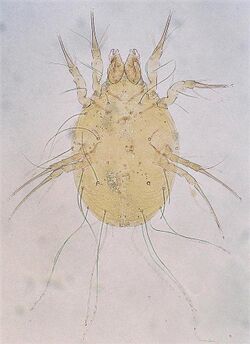Biology:Glycyphagus
| Glycyphagus | |
|---|---|

| |
| Scientific classification | |
| Domain: | Eukaryota |
| Kingdom: | Animalia |
| Phylum: | Arthropoda |
| Subphylum: | Chelicerata |
| Class: | Arachnida |
| Order: | Oribatida |
| Family: | Glycyphagidae |
| Genus: | Glycyphagus Hering, 1838 |
Glycyphagus is a genus of astigs in the family Glycyphagidae.[1][2][3][4]
Description
In adults of Glycyphagus, the prodorsum lacks external vertical setae ve. The internal vertical setae vi are long and barbed, and located posterior to the anterior margin of the propodosoma. The scapular setae si and se are arranged in a trapezoid or rectangle shape. In some species, there is a prodorsal sclerotization called a crista metopica. Some of the dorsal setae are long and heavily barbed. On the ventral side of the body, the subcapitulum has a distinct pattern of ventral ridges, and near the posterior margin of the body is the anus. The tibiae of the first two leg pairs have two ventral setae each. The tarsal claws are simple and small. Members of subgenus Lepidoglyphus have subtarsal scales on the legs.[4]
Females usually have a short external copulatory tube at the posterior end of the body. Males lack paranal suckers or tarsal suckers on the fourth leg pair.[4]
Ecology
Mites in this genus live in a wide variety of habitats, including nests of animals (e.g. rodents, birds, bees), stored products, house dust, hay and grass. They feed on various organic materials.[4]
To disperse, Glycyphagus use insects such as bees (phoresis) or air currents.[4]
Species
These species belong to the genus Glycyphagus:
- Glycyphagus destructor (Schrank, 1781) b g
- Glycyphagus domesticus (De Geer, 1778) b g
- Glycyphagus hypudaei (Koch, 1841) g
- Glycyphagus michaeli (Oudemans, 1903) b
- Glycyphagus ornatus Kramer, 1881 b g
- Glycyphagus pilosus Oudemans, 1906 g
- Glycyphagus privatus Oudemans, 1903 b g
Data sources: g = GBIF,[1] b = Bee Mite ID[4]
Gallery
References
- ↑ 1.0 1.1 "Glycyphagus". https://www.gbif.org/species/2181913.
- ↑ "Glycyphagus Genus Information". https://bugguide.net/node/view/1316095.
- ↑ "Glycyphagus Overview". http://eol.org/pages/3200259/overview.
- ↑ 4.0 4.1 4.2 4.3 4.4 4.5 "Glycyphagus". October 2016. https://idtools.org/bee_mite/index.cfm?packageID=1&entityID=101.
Further reading
- Encyclopedia of Entomology. Springer. 2008. ISBN 978-1402062421.
- Comstock, John Henry (1912). The spider book: A manual for the study of the spiders and their near relatives, the scorpions, pseudoscorpions, whip-scorpions, harvestmen, and other members of the class arachnida, found in America North of Mexico, with analytical keys for their clas.... ISBN 978-1295195817.
- Halliday, R.B.; O’Connor, O’B.M.; Baker, A.S. (2000). "Global diversity of mites". Nature and Human Society—the Quest for a Sustainable World (National Academy Press): 192–203. doi:10.17226/6142.
- A Manual of Acarology (3rd ed.). Texas Tech University Press. 2009. ISBN 9780896726208.
- Norton, Roy A. (1998). "Morphological evidence for the evolutionary origin of Astigmata (Acari: Acariformes)". Experimental & Applied Acarology (Springer) 22: 559–594. doi:10.1023/A:1006135509248.
External links
Wikidata ☰ Q4551844 entry
 |





